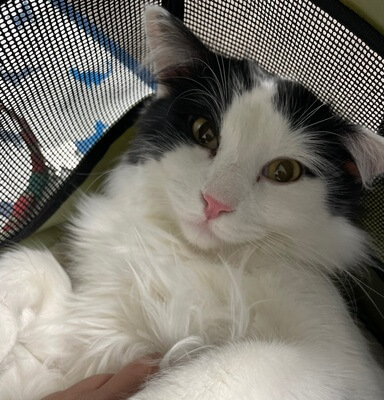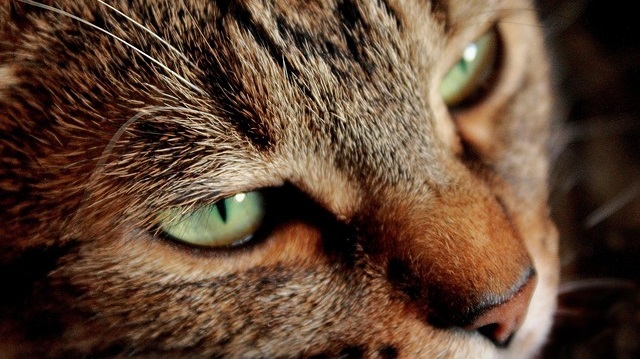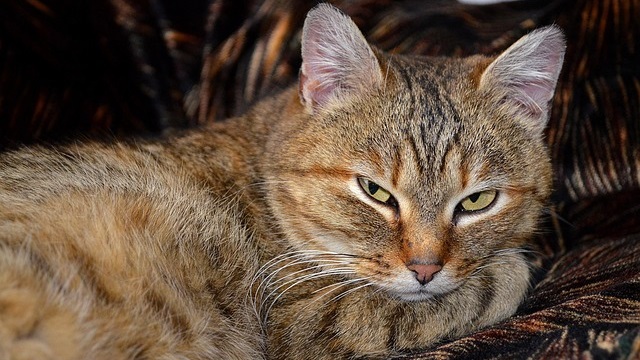Cat Peeing Blood? 7 Possible Causes & When to Act
Noticing your cat peeing blood can be incredibly alarming, especially if they’re otherwise acting normal. Whether it’s a sudden discovery in the litter box or something your vet points out during a checkup, hematuria in cats (the medical term for blood in the urine) is never something to ignore.
A healthy cat’s urine should be clear to light yellow. If you notice a pink or reddish tinge, that’s a strong sign that there’s blood in your cat’s urine. While causes can range from mild inflammation to life-threatening urinary tract obstructions, cat pee blood is never considered normal and always warrants closer inspection. Even if your male cat is peeing blood but acting normal, he could still be experiencing a serious medical emergency.
Cats are experts at hiding discomfort, so your furry friend might seem completely fine while dealing with a condition that’s causing pain or damage. Let’s take a closer look at the most common reasons for blood in cat pee and how to tell when it’s time to take action. Throughout the article, you’ll also learn how Maven Pet helps monitor subtle signs of illness before they escalate.
- Hematuria in cats is never normal and requires immediate veterinary attention.
- Common causes include FLUTD, UTIs, bladder stones, FIC, and tumors.
- Cats often hide discomfort, making behavioral monitoring crucial.
- Maven Pet's smart collar detects early signs of health issues.
- Proactive health monitoring can prevent emergencies and enhance pet well-being.
Why Is There Blood in Your Cat’s Urine?
There are several conditions that can cause blood in cat urine, some more common in male cats and others in females. Below are the most common causes of blood in your cat’s pee, and how to handle each.
1. Feline Lower Urinary Tract Disease (FLUTD)
FLUTD is a broad term covering various conditions affecting a cat’s bladder and urethra. It is a leading cause of blood in cat urine. In male cats, FLUTD is especially concerning due to the risk of complete urinary blockage—a life-threatening situation. According to VCA Animal Hospitals, FLUTD can stem from bladder inflammation, bladder stones, or stress.
- When to worry: Even if your male cat is peeing blood but acting normal, a blockage can happen rapidly.
- What to do next: This is a medical emergency. Contact your vet immediately.
- How Maven helps: Maven Pet’s smart collar monitors nighttime restlessness, activity drops, or discomfort—early signs your cat may be struggling to urinate comfortably.
“Every time Umi is hospitalized, it’s for like four days and it costs over $5,000… Maven has helped me not only save money but also save his life”

★★★★★
Jessica Ortiz
Umi
2. Urinary Tract Infections (UTIs)
More common in female cats, a urinary tract infection can cause blood in their urine due to inflammation. UTIs are usually caused by a bacterial infection and might not show many symptoms beyond peeing blood.
- When to worry: If your cat is straining to urinate or making frequent visits to the litter box.
- What to do next: Schedule a vet appointment for a urinalysis and possible culture.
- How Maven helps: By tracking changes in your cat’s behavior like frequent movement or increased rest periods, Maven helps spot problems before they worsen.

3. Bladder Stones
Crystals or bladder stones can cause irritation in the bladder lining, resulting in blood in cat pee. They may lead to obstruction, especially in male cats.
- When to worry: If you notice a small amount of urine or your cat is straining.
- What to do next: Visit the vet for imaging and treatment, which may include dietary changes or surgery.
- How Maven helps: Maven’s AI can detect night restlessness and reduced movement—signs often linked with urinary pain.
4. Feline Idiopathic Cystitis (FIC)
Feline idiopathic cystitis is bladder inflammation without a clear cause. Stress plays a large role. As explained by Cornell Feline Health Center, cats under 10 years are especially vulnerable.
- When to worry: When there’s blood in the urine following stressful events, like a move or new pet.
- What to do next: Minimize stress and ask your vet about pain relief and dietary changes.
- How Maven helps: Maven tracks stress-related symptoms like abnormal sleep patterns or behavior changes.

5. Bladder or Urethral Tumors
While rare, tumors can cause blood clots or blood in a cat’s urine. These are typically seen in older cats and may come with weight loss or increased urination.
- When to worry: If blood in your cat’s urine is consistent or worsening.
- What to do next: Your vet may recommend ultrasounds or biopsies to diagnose the issue.
6. Trauma or Injury
An injury to your cat’s abdomen or urinary tract can lead to visible blood in cat pee. Trauma could come from a fall, rough play, or an accident.
- When to worry: If your cat is limping, bruised, or hiding.
- What to do next: Visit the vet to rule out internal bleeding or organ damage.
7. Side Effects from Medication or Toxic Exposure
Certain medications or toxins can cause hematuria in cats. Ingestion of antifreeze or lilies, or even medication side effects, can affect the urinary system.
- When to worry: If your cat recently started new meds or had access to household toxins.
- What to do next: Contact your veterinarian and share the full history.
But What If My Cat Is Peeing Blood But Acting Normal?

Even if your male cat is peeing blood but acting normal, don’t assume they’re fine. Cats hide pain extremely well, and what seems like “normal” behavior might mask serious health problems.
Maven Pet can help by alerting you to subtle behavioral shifts that suggest a problem—before you even see blood in your cat’s urine.
What to Watch For
Keep an eye out for these warning signs:
- Frequent trips to the litter box
- Straining to urinate
- Small amount of urine produced
- Licking the genitals
- Peeing outside the litter box
All these symptoms, paired with cat pee blood, should prompt immediate attention.
How Maven Pet Supports Early Detection
Maven Pet uses a smart collar to track your cat’s activity, rest, and itching behaviors 24/7. With real-time insights and health alerts, it helps detect patterns such as discomfort, restlessness, or behavioral changes—early indicators of potential health problems.


Monitor heart rate, respiratory rate, activity & rest, itch behavior.
You can even log observed symptoms in the Maven app, giving your vet accurate information to speed up diagnosis and treatment for issues like blood in your cat’s urine.
Explore the pet smart collar and how it supports overall pet wellness.
Final Thoughts

When you see blood in your cat’s urine, don’t wait—take action. Even if your cat seems fine, underlying issues like FLUTD, bacterial infection, or bladder stones can escalate quickly.
By using Maven Pet’s proactive monitoring, you can catch problems earlier, reduce the need for emergency care, and ensure your pet’s comfort and health long-term.
Being proactive is always better than being reactive. With Maven, you don’t just respond to problems—you stay ahead of them.
Maven Pet focuses on improving the quality of life of our pets with technology, using artificial intelligence (AI) to enable proactive pet care. By accurately collecting and monitoring pet data 24/7 and flagging any irregularities, Maven Pet empowers pet parents and veterinarians to stay ahead of potential health issues, ensuring the well-being and longevity of our beloved companions.




